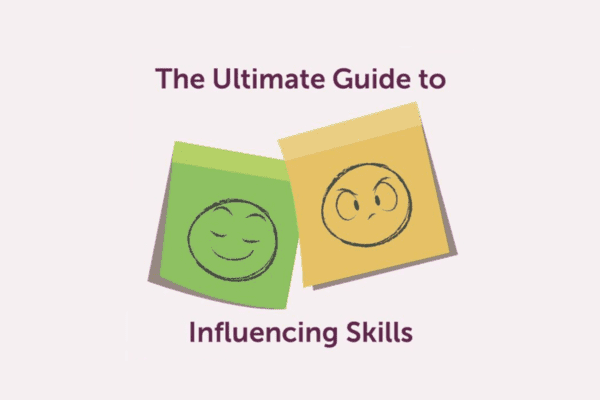Master the Art of Communication
At the core of human existence lies the remarkable ability to convey meanings, ideas, and emotions from one individual or group to another. Through a rich tapestry of understood signs, symbols, and semiotic rules, communication becomes the bridge that connects us all. Hence, the need for good communication skills.
What’s truly fascinating is that communication transcends language barriers, embracing even those who may not utter a single word. Yes, you heard it right—babies, with their innocent coos and gestures, are masters of communication in their own right. So from the moment we enter this world, the intricate dance of exchanging information begins, shaping our relationships, influencing our choices, and defining our understanding of the world.
Now, get ready to unlock the immense power of communication that is forever happening, both within and around us!
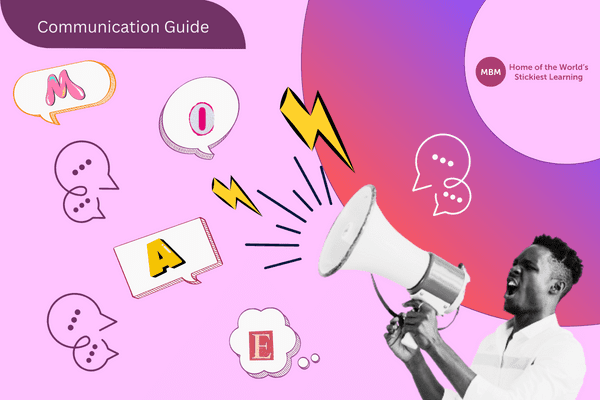
This Ultimate Guide will Cover:
- What are Communication Skills?
- The 5 Elements of the Communication Process
- What are the 4 Types of skills for Effective Communication?
- Ten Barriers to Effective Communication Skills
- The Impact of Poor Communication
- Skills for Communication in the 21st-Century Workplace
- Why is it Important to Listen?
- Five Basic Styles of Communication Skills
- How to Deal with Communication Problems
- Can Better Communication Skills Help Me Get Ahead?
- How to Improve Skills for Communication
- Further Reading and Resources
1) What are Communication Skills?
Firstly, good communication skills are the ability to convey information to others effectively and efficiently. Specifically, these skills are verbal, non-verbal (body language), and written.
People take for granted that communication skills just happen. Actually, communication is viewed uniquely by each person based on experiences or understanding of the topic. So the other person may hold a different impression of what you mean. This refers to a mental filter.
Mental Filters
An example of a mental filter is what the receiver thinks about the sender. If the person receiving the message doesn’t trust the sender then there is a problem. For instance, we can perceive an honest and sincere message from the sender as bossy.
Avoid unintended communications by using a framework for messages. Note a profound and exciting story can grab your audience, or your audience can grab their phones and check the game highlights. The difference is all in the delivery.
To learn more about communication, watch our 1-minute video below:
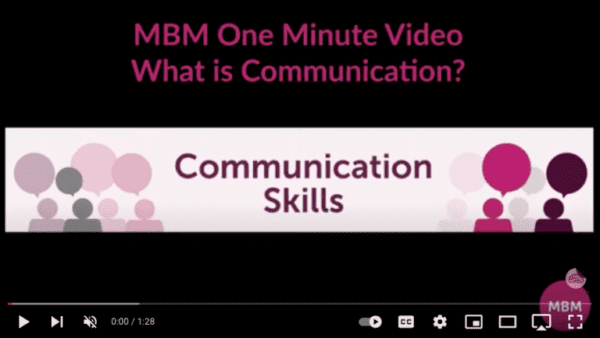
The major mistake in communication is to believe that it happens’ – George Shaw
2) The 5 Elements of the Communication Process
Sender – Receiver – Message – Context – Listening
The process of communication happens in a loop. It starts with the sender as the first element. Feedback or listening is the fifth element and then it circles back to the sender.

#1- Sender
The person starting the conversation (the sender) knows in their mind what they intend the message to be. By knowing the audience, the person can deliver the message in a format the receiver will know best. Then evaluate the other four elements before you deliver the message.
The sender can give the message through text, email, verbal or non-verbal. But regardless of the channel, you still need to follow a framework for the message. This is important so that a message meant to be helpful doesn’t seem indecisive or the opposite, short or rude.
When deciding how to phrase the wording of the message, use the popular and effective Think-Feel-Do (TFD method).
- Think. Example: I want the person to think the project is approved.
- Feel. Example: The employee should feel valued and appreciated.
- Do. Example: I want the person to collaborate with the team.
#2- Receiver
To start, the receiver of a message can be one person or a group. They should pay careful attention to the message. Listen and watch the sender’s body language. The receiver should give non-verbal signals to the sender, like nodding in agreement, and smiling if it applies.
#3- Message
Secondly, the message is made from the channel (text, phone, email) and non-verbal communication such as written skills in communicating. The TFD method also plays a part in the message.
#4- Context/Channel
The context or channel involves the location, method, timing, and relationship.
You should consider the following:
- The confidential nature or emotion of the information. Do you need a quiet office, a large conference room, a newsletter, a television ad, etc?
- Is your information complex and involved or easy to communicate?
- What channel do you think the receiver will most prefer and understand?
- How much time is available?
- How will you answer questions if needed?
#5- Listen and Give Feedback
Listening and giving feedback is important whether it is verbal or non-verbal. Note open-ended questions can gauge your receiver’s understanding of the information. However, errors can occur with feedback, such as:
- Closed-ended questions, for instance, ‘Is that clear?’ Or, ‘Do you understand?’ are used. It may be understood, but the receiver has a different perspective than the sender.
- Not listening or watching for any verbal or non-verbal clues of defensiveness, lack of interest or dishonesty.
3) What are the 4 Types of Skills for Communication?
Do you ever think about HOW you interact with others and what effect it has? Well, each type of communication is used in different circumstances and to convey a different intent. The basic communication types are intended to persuade, inform, or educate.
The following are the 4 types of communication:
- Visual
- Written
- Verbal
- Non-Verbal
#1- Visual Communication Skills
Reading or seeing is visual communication. It can be anything that shows a message, expresses an idea and gives information. For example, signs, gestures, postures, or other avenues that can be expressive.
An example is the female or male-looking stick figures on the door of many public toilets. These are basic symbols that we identify as signalling that this is a women’s or a men’s toilet. Now another example is a thumb’s up gesture. This shows that things are okay.
#2- Written Communication Skills
This is often your first impression of another. It shows your ideas through written symbols. Written skills for communication are the most common form of business communication and include letters, emails, or text messages to name a few. So what is your writing saying about you? And what story are you telling?
Remember these 11 Tips to Improve your Written Communication Skills using Shakespeare.

Important: Whenever you send a written document, still follow the 5 elements as noted above.
Business Writing Done Properly:
Improving your written skills for communication will improve how others perceive you. So always write without banter and ‘fluff’ but still keep it warm to develop rapport. Moreover, business writing should remove any information that does not add to the meaning. It should state the aim directly.
There are an estimated 246 billion emails worldwide sent and received daily. Even more, on average a manager or executive receives 200 emails per day. And every email you send is a chance to showcase your writing.
It’s true people judge others based on their tone. The words you use send a message and you don’t want that message to be incompetent or rude. So learn how to persuade, inform or educate your audience through writing. This shows confidence, knowledge and success!
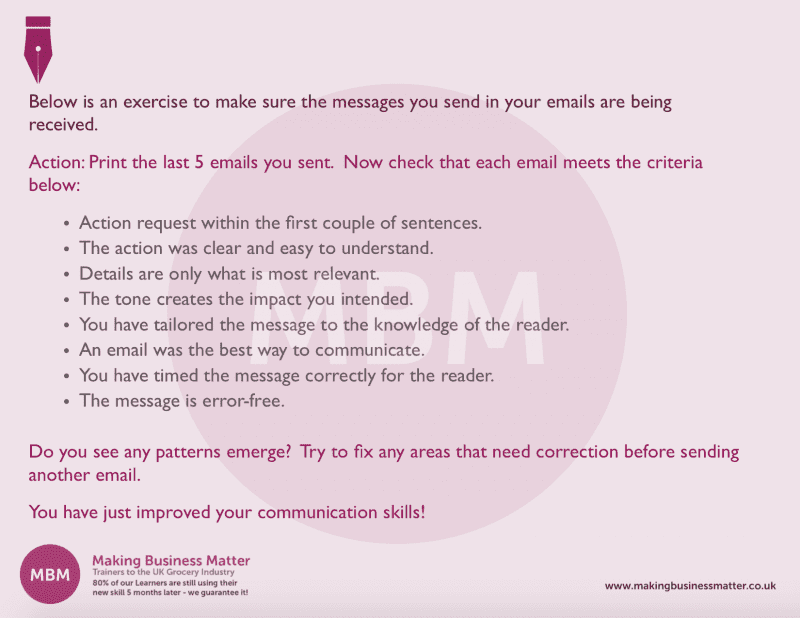
#3- Verbal Communication Skills
Verbal communication is the process of presenting ideas through speech. This is a particularly important skill for people in sales, customer service and business roles. Also, positions working with customers and the public require excellent verbal skills in communicating.
The 4 Types of Verbal Communication:
- Intrapersonal – This is the conversation we have with ourselves. We can choose to keep these conversations to ourselves, for instance, our thoughts. Or we can choose to tell our internal conversation to others.
- Interpersonal – This takes place between two people where each person switches roles between sender and receiver.
- Small-Group – Two or more people are involved. The number of people involved is kept small, so each one is able to give input. Group meetings, press conferences and board meetings are examples of this.
- Public Communication – One person addresses a large group. In essence, one sender to many receivers.
#4- Non-Verbal Communication Skills:
Most people guess what nonverbal communication is, however, they might miss half the story. Non-verbal is as much about listening and observing as showing your non-verbal cues. In short, non-verbal communication tells a deeper story.
An example of non-verbal communication is your response to an employee calling in sick on stock take day. This is the third year in a row it has happened. The night before you saw them at a football game with no visible sickness. You might say ‘Okay? I hope you feel better.’ but the tone of your voice conveys irritation and disbelief.
The 4 Types of Non-Verbal Communication Skills:
- Eye Contact – This is one of the most valued traits. Someone who looks you in the eye shows they are listening and interested. And not looking someone in the eye can seem dishonest, distracted or disinterested.
- Body Language – Body language is strongly tied to psychology. Specifically, it can convey happiness, disapproval, anger, and the list goes on. Some people show body language that does not match their feelings. Thus, it is important to confirm your impression. This may also make the other person defensive or embarrassed. Remember to read your audience and adjust.
- Paralinguistic – A big word referring to inflexion, tone, loudness, pitch and rhythm of your voice. It can express seriousness, boredom, and sarcasm, just to name a few.
- Facial Expression – This is anything on our face that conveys a response to what we hear or say. Lifted eyebrows, pursed lips, and smirking are examples, as also, eye contact.
60 % of all human communication is nonverbal body language; 30 % is your tone, so that means 90 % of what you are saying doesn’t come from your mouth.’ – Alex Hitchens.
Excuse the Interruption, but Here’s a Little Bit About Us…
We are the soft skills training provider to the UK Grocery Industry, helping Suppliers to win more business. They choose us because of our money-back guarantee, our relevant experience, and because we make their learning stick.
Click this image to learn more about MBM’s signature sticky learning method:

We are the soft skills training provider, partnering with clients that are frustrated by people returning from training courses and then doing nothing differently. Our clients choose us because we achieve behavioural change through our unique training method, sticky learning ®.
4) Ten Barriers to Effective Communication Skills
Communication can be slowed or stopped due to barriers. Some communication barriers are:
- Language barriers – Different language or accent.
- Linguistic ability – Jargon or buzzwords.
- Physical barriers – Actual distance between sender and receiver.
- Attitudinal barriers – Personality conflicts, poor management, and resistance to change.
- Psychological – Behavioural and mental aspects, including anger and stress.
- Ambiguity – Words that sound the same with different meanings.
- Physiological – Discomfort, ill health, poor eyesight or hearing.
- Technology – Multitasking and condensation of information.
- Fear of being criticised – Not wanting embarrassment or criticism.
- Gender barrier – Specific traits of conflict resolution and communication that are based on gender.
5) The Impact of Poor Communication
The cost of poor interaction can have a big impact. We often take small misunderstandings in stride and chalk them up to an error. When this happens, take time to reflect. Why did the disconnect happen to begin with? Furthermore, did you contribute to the problem? Often, it is not until large or complex problems come up do we stop to find the cause. Yet, the same primary faults create small problems as large ones.
When Workplace Communication Fails
The time and cost involved in the daily interactions of workers are hard to measure. Areas that are not productive are addressed and resolved.

This mishap could increase the original cost of the interaction. Companies can help by investing in a communication skills training course for their employees.
Employees cannot practice skills that they are not trained in. Even so, employees are held responsible for the problems. Finally, employers are starting to estimate more closely the loss of wages to the company. Therefore, companies are including courses on skills for communication in their training budget.
Speak when you are angry, and you will make the best speech you will ever regret.’ – Ambrose Bierce.
6) Skills for Communication in the 21st-Century Workplace
The skills you need today are evolving at a rapid pace. But they need to, in order to keep up with the rapidly changing business world. Companies create products in record time and make quick decisions involving many people. In-person discussion is becoming less and less common. This is in part because the physical location of coworkers in a global market varies. Your job requires you to interact and collaborate with many types of people and because skills for effective communication are lacking in organisations, we need basic ways to work with one another.
Employers are moving away from slower methods of communication such as desk phones. And this is in favour of artificial intelligence-based products such as apps, chatbots and voice assistants. All in all, the drive for productivity is leading the effort. There are countless technologies coming out at lightning speed. Yet, humans will need to still interact with clarity, despite barriers.
Problems Arising- 21st-Century Communication
Global businesses give access to millions more people than would be possible for a local company. This requires adjustments that companies do not train their employees in. Consequently, the lack of skills today can cause lost contracts, employee turnover, and frustrated customers. If your organisation is not global, it still impacts you because of global suppliers and customers. Thankfully, training will help you to remain successful when interacting with others.
Examples of Modern Communication Barriers
#1- Physical Location
Difficulties can happen when working with others in another time zone. An example would be a coworker in the United Kingdom working with someone in the United States. And there is a five-hour time difference. The start of business in the U.K. may be 4:00 am in the U.S.
On the same note, there is an increase in email usage even to give complex messages. And we know complex topics are better discussed in person or by phone. This can lead to misunderstandings and delays. Everyday information is okay. However, when decisions are needed or participation is required, it is inconvenient. Not to mention it impacts the relationship of coworkers.
Talk over what working hours will work to contact the other person. The person in the U.S. may not mind being contacted at 6:00 am. However, to be nice, the U.K. does not contact the U.S. worker until U.S. office hours. Remote worker situations can be a challenge. Furthermore, employees may not even be in a different time zone but located off-site. Yet, this can still isolate the employee and complicate communication.
#2- Generational Differences
Employees are working longer. Actually, much longer. In fact, recent studies suggest that workers aged 55 and older currently make up 16% of the total workforce in the European Union. For comparison, for every 10 Generation Z employees, there are 12 people aged 65 or older in the EU.
Workers are staying in jobs longer for many reasons, for example:
- Lack of financial savings.
- Longer, healthier living means a person can still work.
- Workers stay due to talent shortages to fill their roles.
- Some people enjoy their job and want to remain productive.
But regardless of the reason, working with multiple generations in the workforce requires consideration. Keep in mind that many ideas about older workers can often be stereotypes. These include a slow pace, resistance to training and new ideas.
#3- Understand That Stereotypes May Not be True
An example is older workers and technology:
Older workers rarely have the technology skills that younger workers do. The communication style present today is not what the older generation was raised with. This changes with each generation.
An example of this would be a direct message (DM) or an instant message (IM). Many older workers prefer to contact by phone or email and may not be familiar with a DM or IM. Actually, they also may not see the benefit in it. Younger workers use it more often and the familiar tool is second nature as they have grown up with it. To a younger or middle-aged person, this is an effective and quick way to ask a question or inform. It is fast and doesn’t require a full-blown email or phone call.

#4- Cultural Differences
An obvious difference between employees being from different countries is language. We can misinterpret the intended meaning and cause offence and feelings of resentment. This is a frequent issue when using Google Translate or something similar to translate a message. The semantics of the message are different from the intended message. And even if the other person gets the concept, more explanation is needed. Whether by personality or culture, some people are direct and to the point. But this can be taken as cold and rude.
#5- Advanced Technology
The virtual world and the global workplace are similar. In both places, a process of communication should be followed. This requires observing the other person. Now with technology, you may use the latest and greatest tools. However, if a coworker in an impoverished country cannot access these tools, then you need to make accommodations. It’s just as in person. If a person has a barrier to communication, then you need to adjust your style.
An example of this would make certain that everyone involved has access to the same technology. For instance, five people use a team app such as Slack, however, two others can only use email. You need, therefore, to provide a summary of all discussions through Slack. Then forward this to the two individuals via email and request their feedback. Lastly, if this occurs, try to make efforts to find a programme that works for everyone.
7) Why is it Important to Listen?
To listen is to learn. However, hearing is different from listening. You don’t become a better listener simply by hearing more. Listening is intentional and focused. There are many aspects to listening. When you practice focused listening, you start to realise those details. It is a skill. And your practice can be with strangers, friends, or coworkers.

Listening happens as much with your eyes as with your ears. Consider eye-rolling for annoyance, or head nodding in agreement. Non-verbally we can observe with our eyes. Also, exclamation marks or words written in all caps can signal anger or excitement. Any uncertain actions mean the sender needs to clarify the message. It is up to the sender to craft a message that the receiver is able to understand with clarity. Oversight because of the wrong context or channel should not be blamed on the receiver.
Questioning
To help determine if a message was clear or to get further information, you can use questioning.
- Open-ended questions. These require a longer answer with some detail.
- Closed-end questions. Questions that are answered with one-word answers. Yes, no, maybe. They stop the conversation.
- Funnelling. Start with general questions and then ask questions that drill down on that topic. Each question is more direct and decisive. This is a common tactic with police.
Focused Listening
There are 6 key qualities of focused listening:
- Smile genuinely as this builds warmth and rapport.
- Appear alert by standing or sitting with good posture and look attentive.
- Show your focus. Control distractions and fidgeting.
- Find a commonality either personal or professional.
- Keep it positive. Don’t complain or say negative things about others.
- Finally, ask open-ended questions as this keeps the conversation ball rolling.
Listen with curiosity. Speak with honesty. Act with integrity. The greatest problem with communication is we don’t listen to understand. We listen to reply. When we listen with curiosity, we don’t listen with the intent to reply. We listen for what’s behind the words.’ – Roy T. Bennett.
8) Five Basic Styles of Good Communication Skills
When you know your style of communication, then you can interact confidently when encountering the individual styles below:
- Assertive
- Aggressive
- Passive-aggressive
- Submissive
- Manipulative
The five basic styles of communication each use corresponding verbal and non-verbal characteristics. Each style has common words and phrases.
#1- Assertive
Firstly, this is mentally and emotionally the healthiest of the styles. However, the fewest people use this style of communication. They advocate for themselves and state their needs. They address issues as they arise.
#2- Aggressive
People express their emotions and opinions with a domineering attitude that can often be harmful to others.
#3- Passive Aggressive
Individuals seem calm and passive but bring down others in subtle ways. This is often because they cannot directly deal with their anger or resentment.
#4- Submissive
Is about pleasing other people. They believe others’ needs are more important than their own. Also, they think others can contribute more than they can.
#5- Manipulative
Finally, this is a type of person with their best interest in mind. They are cunning and good at influencing and controlling others. They ask indirectly for their needs to be met, making others feel sorry for them.
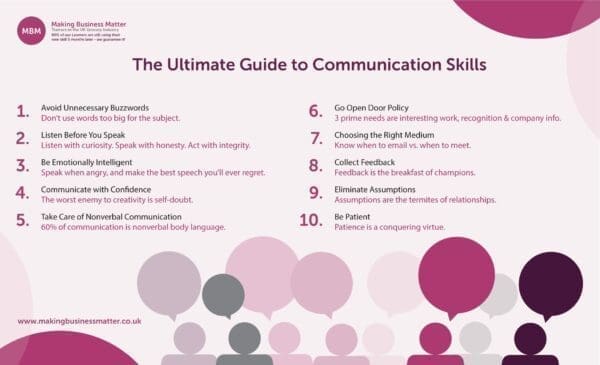
Don’t use words too big for the subject. Don’t say infinitely when you mean very; otherwise, you’ll have no word left when you want to talk about something really infinite.’ – C.S. Lewis.
9) How to Deal with Communication Problems
The best way to communicate with others is not a guessing game. Follow the details below and you will have smooth interactions going forward. Communication problems will be helped if you understand where the process stopped working.
Find where the misunderstanding occurred, and you resolve the issue quicker. Whether you can determine the point of the communication problem or not, you need to open the communication channel. You can start this by using the following communication skills examples.
#1- Show Empathy and Listen with Intent
Establishing dialogue can be scary and uncertain for both parties. Make the person comfortable and create a secure environment to share information. First, let them know you understand their message by practising methods of effective communication. Show you are a trusted individual by focused listening and using the best method for them. Lastly, let them know you would like to help solve the issue. This is done through verbal and non-verbal communication.
#2- Questioning
Use the questioning method of communication to ask good, relevant questions. Then evaluate additional details. Also, match the tone and pace of the other person so it does not appear that you are rapid-firing questions. Give the person enough space and time to convey information.
#3- Provide Guidance
It is likely the person has come to you for help in solving the problem. Part of a leader’s role is working together to figure out the next best steps. Further investigation is often the next step. Brainstorm ideas together and detail what should happen next. Get answers from others if needed. Make it clear you would like to improve or solve the problem. The issue is important to them and to you.
#4- Follow Up
Be certain the person knows when they will hear from you. Recap the overview of the conversation. The recap should be written and documented so they can correct any errors. A letter or email is appropriate to use. Anything wrong in the wording or meaning should be corrected and a new recap sent. Regardless if you are a manager, human resources, or an employee; set the tone and follow the process. It will reduce future communication problems and furthermore, headaches.
10) Can Better Communication Skills Help Me Get Ahead?
As mentioned, skills for communication are a hot commodity. Human resource departments are actively seeking out high-end soft skills. To further demonstrate, these skills show you are flexible and can be trained for future positions.
State your level of skills on your CV. Then during a phone interview, you can describe examples of how you have used the skills. When you get the in-person interview, show concrete examples. In particular, use body language that portrays self-confidence.
For Example:
- Sales would need articulation, negotiation skills, persuasion, wit, clarity in speaking, and presentation skills.
- Customer service would need conflict management, interpersonal skills, empathy, warmth, and negotiation.
- Human Resources would need listening, interpersonal, social, conflict management and people management skills.
- Purchasing would need accuracy, negotiation, and conflict management.
Take a cue from the job description. Ensure you include areas from the company’s core values to tie into the culture.
Try searching on a job board for your best communication trait. For example, negotiation. As a result, you might be interested in the results. In fact, a wide range of opportunities and industries could be open to you. Your cover letter should lead with your solution to their problem. What problem can you fix that is a key component of the job?
Good Communication Competency
This improves the skills and relationships you bring to a company. Companies now create assessments around this competency before hiring. Will you make the cut?
The Job Interview: The Importance of Networking
Low rates of unemployment and a high number of applicants for each job. This scenario makes networking imperative. It can help get your foot in the door for the interview.
Use a framework of pitching to create a successful request. Remember, you never know if you never ask.
Advice from LinkedIn Learning encourages us to Use the What–Why–How – format.
Be direct when you ask.
- What. State the action you need directly.
- Why. Create urgency.
- How. Make the next steps for the decision-maker as easy as possible.
Let’s Try an Example:
You sent out countless CVs but did not get a call. A position has opened up where an old acquaintance works but you are reluctant to reach out. It is uncomfortable to ask a favour from this person even though you had a good history.
- What action do you need? An opportunity with your organisation has opened up and I would like to get your insight on the position.
- Why is this time-sensitive? My current company has shut its doors. As the only income in my house, I am actively looking for a new position.
- How are the next steps easy for me to take? Would you be willing to tell me about what your company values in an employee? Can I put your name down as a reference? I am finished with the application aside from references.
This scenario should give a successful ask.
Take your questioning a step further with 5 Bums on a Rugby Post:
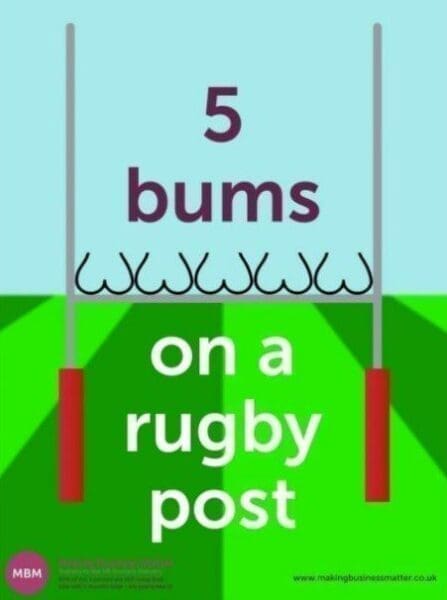
As you can see from the image we’ve extended it a bit further. Firstly, the rugby post forms an ‘H’. This is for ‘How’. Each of the bums is a ‘W’. These remind us of five open questions, ‘Who’, ‘What’, ‘When’, ‘Where’, and ‘Why’. You should think about your pitch and ask these questions. This is an easy way to remember all the questions you need to answer to be prepared for any eventuality.
Communication Skills in An Interview:
An interview can be daunting. So use the five elements of the communication process and you are certain to look prepared!
1- Sender – You deliver solid and quantified examples.
2- Receiver – The interviewer uses proper communication methods to listen and understand your message.
3- Message – Through body language you portray self-confidence. Through the clarity of speech, you show capability. You have a logical order for your presentation. Your ideas are easy to understand.
4- Context – You present through the visual slideshow and physical products you have designed.
5- Feedback – You ask questions to make sure they understand your capabilities and interests. You receive their feedback. You get a callback!
Show Off Your Skills on a CV
The old ways of adding keywords to your CV would be enough to get a phone call. Now you need to go much further to get your name and CV in front of a decision-maker.
Applicant tracking systems are designed to find the best candidate, on paper. Your desirable traits can only be found by self-promotion. One area of self-promotion is to include keywords on your CV that match the primary job description or functions.
Match your skills to where the industry is going. Understand trends in the industry and keep up with major news in the field.
Conduct a Meeting
Meetings are a hot spot for communication difficulties. People from different countries or remote workers may chime in. The meeting could contain several departments and functions. Each department, such as accounting, human resources, and sales has different perspectives.
It is helpful in a meeting with a lot of information and various knowledge bases to have a facilitator. This person will direct the verbal traffic of the meeting.
The facilitator pays attention to comments, questions, and non-verbal cues. Paraphrasing or recapping the comment helps to know if the intent is understood. It also engages in conversation.
Recap of Non-Verbal Cues Can Sound Something Like:
‘Mike, it looks like you have concerns’ or ‘Jill, did you want to add something?’ This gives someone an open invitation to discuss. You are also receiving verbal affirmation of the other person’s views.
Reuse the same verbiage or subtle gestures as the person or group you are communicating with. Match the other person’s words, tone or gestures to give a sense of commonality. When someone identifies with another, they can share their ideas without fear.
11) How to Improve Skills for Communication
The easiest way to improve your skills for communication is to attend a training session to help you to get your message across more succinctly and effectively. Formal training will help you understand the theoretical models in the classroom.
Moreover, it will give you the chance to practice in a safe and comfortable space. We suggest taking our Communication Training Course, or a shorter course to refine your skills for a specific situation, for instance, meetings. It is then critical that you embed the skills by using them in your day-to-day role.

If you prefer a more personal and bespoke touch, we suggest you consider getting someone to coach you. Generally, this could be an external professional or someone you trust in the business to push you. The main purpose of executive coaching is to help you think about your behaviours and skills differently. Moreover, to make sure that you are being held accountable for using the skills you have. Importantly, you only become better by pushing yourself to use new models and challenge your existing behaviours.
For more information, please contact us or fill out the form at the end of this article. Our trainers are from your industry and can provide training on any one of our products, from Myers Briggs and GSCOP to Category Management, and HBDI. Furthermore, we use our unique Sticky Learning method, and as a result, we guarantee to make your learning stick.
Communication Skills – In Summary
They improve relationships, seal deals, and help you to negotiate a pay rise. The importance of skills in communicating in life cannot be overstated. Consequently, they are vital to success in every relationship. Without a doubt, communication is the product of the future. So improving your skills for communication through training is a great way to see real results in your personal and professional life.
Assumptions are the termites of relationships.’ – Henry Winkler.
12) Further Reading and Resources
You can find further insight, detailed definitions and clarification of all the key skills in communicating terms mentioned in this guide in our Communication Skills Glossary.
#1- Relevant Blog Articles
- What is communication?
- The art of communication.
- Grapevine communication.
- Communication channels.
- 2-way communication.
- Communication filters.
- Trade communications.
- Johari Window.
#2- On Topic Quotes
‘We have two ears and one mouth so we can listen twice as much as we speak’. – Epictetus.
‘Research indicates that employees have three prime needs: Interesting work, recognition for doing a good job, and being let in on things that are going on in the company.’ – Zig Ziglar.
‘Know when to email vs. when to meet. Logistics are best handled over a non-immediate communication channel like email or Asana tasks. Detailed status meetings will suck the life out of your day.’ – Justin Rosenstein.
‘Feedback is the breakfast of champions.’ – Ken Blanchard.
#3- Videos About Skills for Communicating
Then, watch our Communication Skills playlist from our YouTube channel:

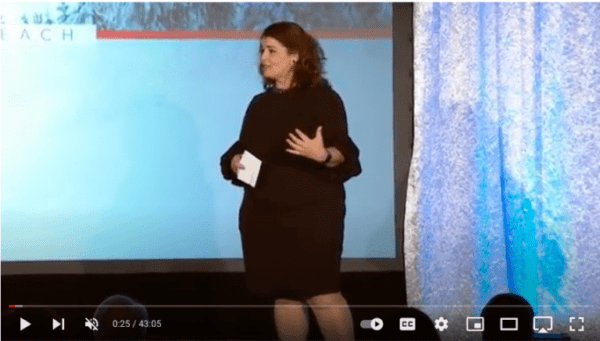
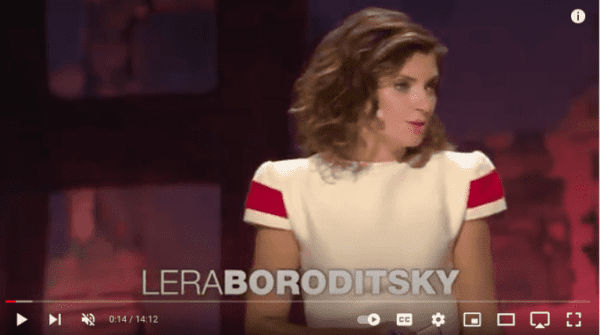
#4- Contact Us
Lastly, feel free to get in touch to find out about how our Communication Skills Course can help you. Simply contact us or email us at helpme@makingbusinessmatter.co.uk, and we will be happy to get back to you.


